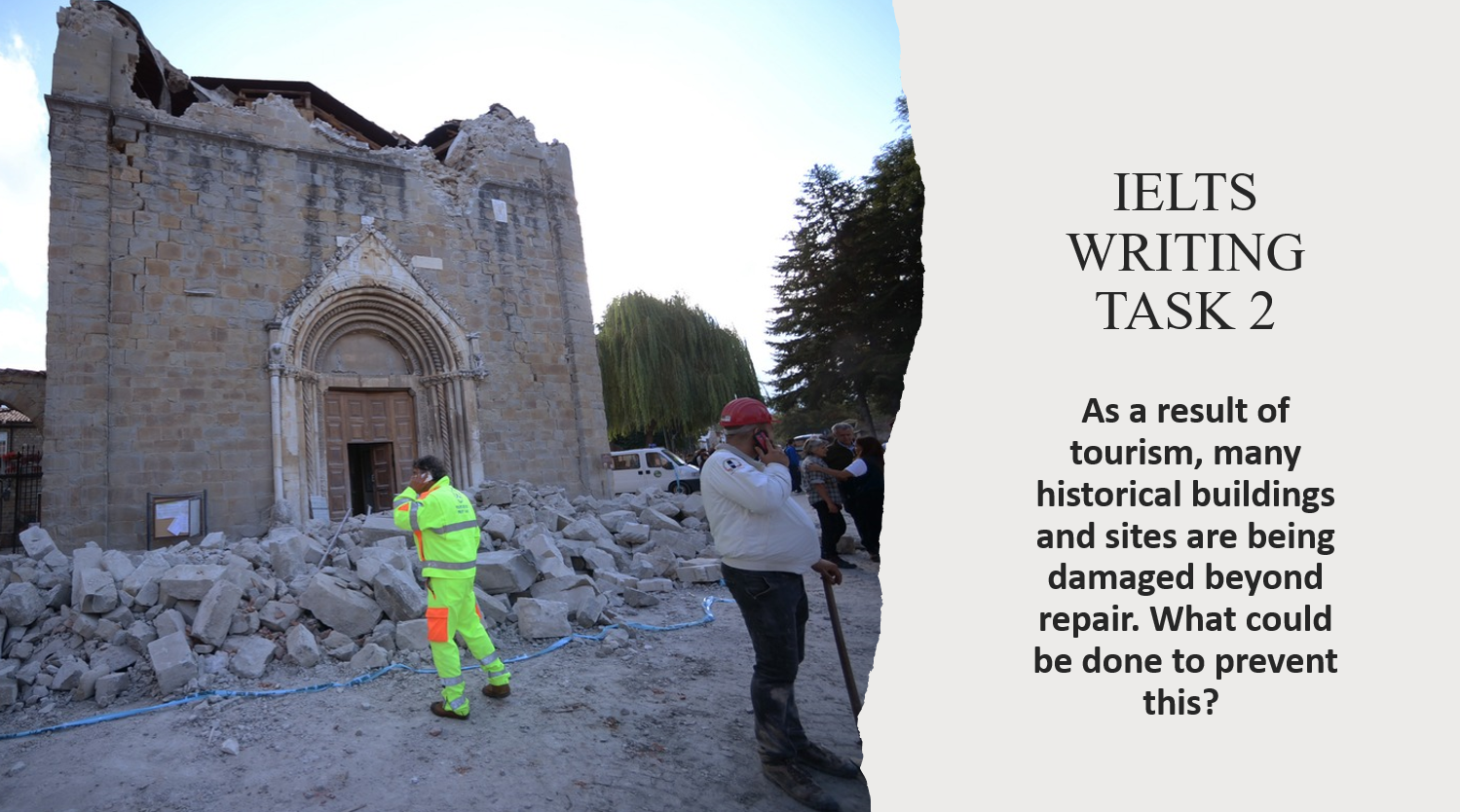Chào các bạn, Hà English rất vui được chia sẻ với các bạn một bài mẫu IELTS Writing Task 2 trên chủ đề “Tourism” – bài viết dạng câu hỏi về vấn đề và giải pháp. Trong bài viết này, Hà English sẽ trình bày về vấn đề đang diễn ra do du lịch gây ra, đó là việc nhiều công trình và di tích lịch sử bị hủy hoại đến mức không thể sửa chữa được.
Chúng ta sẽ tập trung vào việc đưa ra các giải pháp để ngăn chặn tình trạng này. Điều này bao gồm việc tăng cường quản lý và giám sát, tạo ra các biện pháp bảo vệ hiệu quả, và nâng cao ý thức của cả du khách và cộng đồng địa phương. Hãy cùng Hà English thảo luận về những cách giải quyết vấn đề này để bảo vệ di sản văn hóa của thế giới.

Mục lục
Đề bài:
As a result of tourism, many historical buildings and sites are being damaged beyond repair. What could be done to prevent this?
Các bước làm bài IELTS Writing Task 2 dành cho đề bài trên
Step 1: Understand our Task
Our task revolves around addressing the issue of historical buildings and sites being damaged beyond repair due to tourism and proposing preventive measures.
Bước 1: Hiểu rõ nhiệm vụ của chúng ta
Nhiệm vụ của chúng ta xoay quanh việc đối phó với vấn đề các công trình và di tích lịch sử bị hỏng hoàn toàn do du lịch và đề xuất các biện pháp phòng ngừa.
Step 2: Decide our Position
In this essay, we will emphasize the significance of preserving historical buildings and sites while acknowledging the role of tourism in their conservation. We will explore measures that balance the promotion of tourism with the protection of historical heritage.
Bước 2: Quyết định quan điểm của chúng ta
Trong bài luận này, chúng tôi sẽ nhấn mạnh sự quan trọng của việc bảo tồn các công trình và di tích lịch sử trong khi công nhận vai trò của du lịch trong việc bảo tồn chúng. Chúng tôi sẽ khám phá các biện pháp kết hợp việc quảng cáo du lịch với việc bảo vệ di sản lịch sử.
Step 3: Extend our answer
Measures to Prevent Damage to Historical Buildings and Sites:
- Visitor Education: Implementing informative signage, guided tours, and educational programs can raise awareness among tourists about the importance of preserving historical sites.
- Visitor Limits: Regulating the number of visitors allowed at a time can reduce overcrowding, minimizing wear and tear on historical structures.
- Infrastructure Maintenance: Investing in regular maintenance and restoration projects can prevent the deterioration of historical buildings and sites.
- Entry Fees: Charging entrance fees can generate funds for conservation efforts and deter casual tourists.
- Strict Regulations: Enforcing strict guidelines for construction and development in the vicinity of historical sites can prevent damage from nearby infrastructure projects.
Bước 3: Mở rộng câu trả lời của chúng ta:
Biện pháp để ngăn chặn sự hỏng hoàn toàn các công trình và di tích lịch sử:
- Giáo dục du khách: việc triển khai biển chỉ dẫn có thông tin, các chuyến tham quan hướng dẫn và các chương trình giáo dục có thể tạo sự nhận thức cho du khách về sự quan trọng của việc bảo tồn các di tích lịch sử.
- Hạn chế số lượng khách tham quan: quy định số lượng du khách được phép tham quan cùng một lúc có thể giảm thiểu tình trạng quá đông đúc, giảm thiểu sự hao mòn trên các công trình lịch sử.
- Bảo dưỡng hạ tầng: đầu tư vào các dự án bảo dưỡng và phục hồi định kỳ có thể ngăn ngừa sự suy sụp của các công trình và di tích lịch sử.
- Phí vào cửa: thu phí vào cửa có thể tạo nguồn tài trợ cho các nỗ lực bảo tồn và ngăn du khách tình cờ.
- Quy định nghiêm ngặt: áp dụng hướng dẫn nghiêm ngặt cho xây dựng và phát triển trong khu vực gần các di tích lịch sử có thể ngăn ngừa sự hỏng hóc từ các dự án hạ tầng gần đó.

Full Sample Essay
Introduction
The adverse impact of tourism on historical buildings and sites, resulting in irreversible damage, is a matter of growing concern. While tourism can provide valuable exposure to these cultural treasures, it also poses a threat to their preservation. This essay aims to explore effective measures to prevent the deterioration of historical buildings and sites due to tourism. We believe that a balanced approach that educates tourists, regulates visitor numbers, maintains infrastructure, charges entry fees, and enforces strict regulations is crucial to safeguarding our historical heritage.
Body Paragraph 1 (Visitor Education and Regulation)
One key strategy to protect historical sites is to educate visitors about their significance. Implementing informative signage, guided tours, and educational programs can enhance tourists’ awareness of the cultural and historical value of these sites. Additionally, regulating visitor numbers is vital. Overcrowding can accelerate wear and tear on historical structures, leading to their degradation. Limiting the number of visitors at a time can help mitigate this issue, ensuring that these sites remain well-preserved for future generations.
Body Paragraph 2 (Maintenance and Funding)
Another essential aspect of preserving historical buildings and sites is investing in regular maintenance and restoration projects. Time and exposure to the elements can take a toll on these structures. Allocating funds for maintenance and restoration ensures that these sites are well-maintained and protected from irreversible damage. Entry fees can be a sustainable source of funding for such efforts, as they generate revenue that can be reinvested in conservation projects.
Conclusion
In conclusion, the preservation of historical buildings and sites in the face of tourism-related damage requires a multifaceted approach. While tourism can provide valuable exposure, it also carries risks to these cultural treasures. To prevent irreversible damage, it is essential to educate visitors about the historical significance, regulate visitor numbers, invest in maintenance and restoration, charge entry fees, and enforce strict regulations in the vicinity of historical sites. By implementing these measures, we can strike a balance between promoting tourism and protecting our invaluable historical heritage.
Vietnamese Translation of Key Vocabulary and Phrases
- Visitor Education: Giáo dục khách tham quan
- Visitor Limits: Giới hạn số lượng khách tham quan
- Infrastructure Maintenance: Bảo trì cơ sở hạ tầng
- Entry Fees: Phí vào cửa
- Strict Regulations: Quy định nghiêm ngặt
- Conservation efforts: Các nỗ lực bảo tồn
- Cultural treasures: Báu vật văn hóa
- Wear and tear: Sự mòn, hao mòn
- Regulation of visitor numbers: Quy định số lượng khách tham quan
- Sustainable source of funding: Nguồn tài trợ bền vững
Xem thêm các bài viết IELTS Writing Task 2 khác TẠI ĐÂY
Tổng kết
Qua bài viết này, chúng ta đã xem xét cách ngăn chặn hủy hoại các công trình lịch sử và di tích văn hóa do du lịch gây ra. Chúng ta đã thấy rằng một sự kết hợp giữa quản lý hiệu quả, sự tham gia của cộng đồng địa phương, và sự nâng cao ý thức của du khách có thể đóng một vai trò quan trọng trong việc bảo vệ di sản này. Hà English hy vọng rằng bài viết này đã giúp bạn hiểu rõ hơn về cách viết một bài luận Task 2 với câu hỏi về vấn đề và giải pháp.
Nếu bạn đang tìm kiếm một trung tâm Anh ngữ uy tín và chất lượng, Hà English là một sự lựa chọn tuyệt vời. Với hơn 10 năm kinh nghiệm trong lĩnh vực giảng dạy tiếng Anh, trung tâm đã đạt được uy tín cao trong việc đào tạo học viên về ngoại ngữ.

Hà English tự hào là một môi trường học tập chuyên nghiệp và thân thiện, với đội ngũ giáo viên có trình độ cao và giàu kinh nghiệm. Những giảng viên tại trung tâm không chỉ sở hữu kiến thức chuyên môn vững vàng mà còn có khả năng tạo động lực và sự hứng thú trong quá trình học tập của học viên.
Dạy từ tâm – nâng tầm tri thức
Nhận tư vấn lộ trình ngay!
